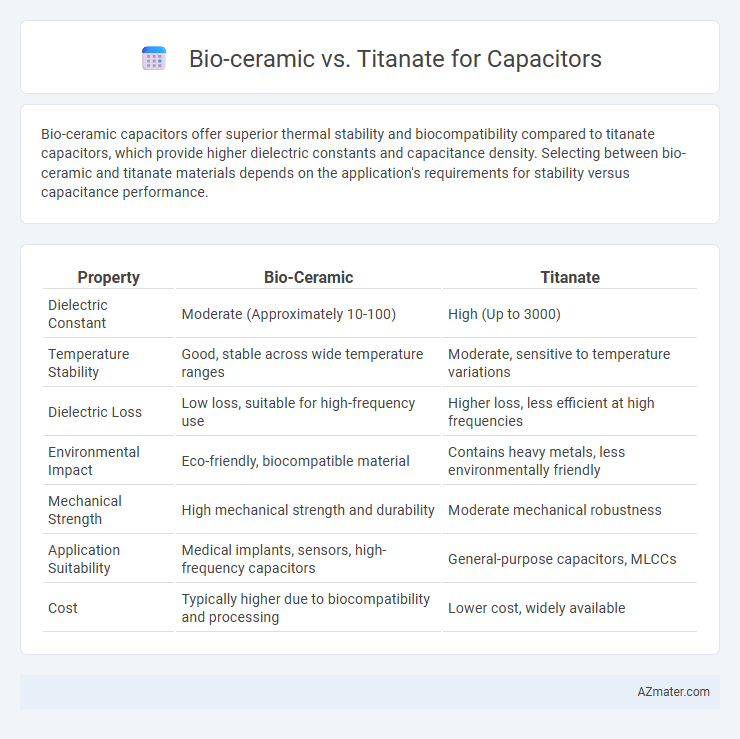Bio-ceramic capacitors offer superior thermal stability and biocompatibility compared to titanate capacitors, which provide higher dielectric constants and capacitance density. Selecting between bio-ceramic and titanate materials depends on the application's requirements for stability versus capacitance performance.
Table of Comparison
| Property | Bio-Ceramic | Titanate |
|---|---|---|
| Dielectric Constant | Moderate (Approximately 10-100) | High (Up to 3000) |
| Temperature Stability | Good, stable across wide temperature ranges | Moderate, sensitive to temperature variations |
| Dielectric Loss | Low loss, suitable for high-frequency use | Higher loss, less efficient at high frequencies |
| Environmental Impact | Eco-friendly, biocompatible material | Contains heavy metals, less environmentally friendly |
| Mechanical Strength | High mechanical strength and durability | Moderate mechanical robustness |
| Application Suitability | Medical implants, sensors, high-frequency capacitors | General-purpose capacitors, MLCCs |
| Cost | Typically higher due to biocompatibility and processing | Lower cost, widely available |
Introduction to Capacitor Dielectrics
Capacitor dielectrics play a crucial role in determining a capacitor's performance by affecting its capacitance, dielectric loss, and thermal stability. Bio-ceramic materials offer environmentally friendly, sustainable alternatives with excellent dielectric properties and biocompatibility, often used in specialized applications requiring low toxicity. Titanate-based dielectrics, particularly barium titanate, dominate the market due to their high permittivity, reliability, and suitability for multilayer ceramic capacitors (MLCCs) in electronics.
What Are Bio-Ceramic Materials?
Bio-ceramic materials, used in capacitors, are advanced ceramic composites that combine biocompatibility with high dielectric properties, enabling efficient energy storage and stability. These materials typically consist of bioactive or bioinert ceramics such as hydroxyapatite or zirconia, which provide superior insulation and enhanced performance under varying environmental conditions. Bio-ceramics offer advantages over titanate capacitors by exhibiting improved thermal stability, lower dielectric loss, and reduced environmental impact while maintaining high permittivity.
Understanding Titanate Materials
Titanate materials, such as barium titanate, are widely used in ceramic capacitors due to their high dielectric constant and temperature stability, enabling efficient energy storage in compact electronic components. These titanates exhibit excellent ferroelectric properties, which enhance capacitance and improve performance in high-frequency applications. Compared to bio-ceramic alternatives, titanate capacitors offer superior reliability and consistent electrical characteristics under varying environmental conditions.
Key Electrical Properties Comparison
Bio-ceramic capacitors exhibit high dielectric constant and low dielectric loss, making them suitable for stable energy storage and efficient signal filtering. Titanate capacitors, particularly barium titanate, offer superior temperature stability and high capacitance density, enabling reliable performance under varying thermal conditions. The choice between bio-ceramic and titanate materials hinges on the required dielectric constant, temperature coefficient, and loss tangent for specific capacitor applications.
Temperature Stability and Performance
Bio-ceramic capacitors exhibit superior temperature stability with a wide operating range typically from -55degC to 125degC, maintaining consistent capacitance and low dissipation factor under thermal stress. Titanate capacitors offer high permittivity but tend to suffer more capacitance variation and increased dielectric losses at elevated temperatures above 85degC. For applications demanding reliable performance over broad temperature fluctuations, bio-ceramic materials provide enhanced durability and electrical stability compared to titanate dielectrics.
Environmental Impact and Safety
Bio-ceramic capacitors exhibit lower environmental impact due to their use of non-toxic, naturally derived materials that are more biodegradable and easier to recycle compared to titanate capacitors, which often contain heavy metals and rare earth elements. The manufacturing process of bio-ceramics produces fewer hazardous byproducts and reduces energy consumption, enhancing their sustainability profile. Safety-wise, bio-ceramic capacitors are less prone to thermal runaway and chemical leakage, making them safer for electronic devices and surrounding ecosystems.
Cost and Manufacturing Considerations
Bio-ceramic capacitors typically offer lower material costs and easier scalability in manufacturing due to abundant raw materials and well-established processing techniques. Titanate capacitors, while often delivering superior performance in high-temperature and high-voltage applications, incur higher production costs because of complex synthesis and stricter quality control requirements. Choosing between bio-ceramic and titanate capacitors involves balancing cost-efficiency against specific performance needs and manufacturing feasibility.
Applications in Modern Electronics
Bio-ceramic capacitors offer high dielectric constants and excellent temperature stability, making them ideal for precision applications in medical devices and wearable electronics. Titanate capacitors provide superior voltage tolerance and low dielectric loss, which are crucial for power supply filtering and automotive electronics. Modern electronics benefit from the complementary properties of both materials, optimizing performance in compact, high-frequency circuits.
Longevity and Reliability Analysis
Bio-ceramic capacitors exhibit high stability and resistance to environmental stress, ensuring prolonged longevity in applications with fluctuating temperatures and humidity. Titanate capacitors offer superior capacitance per volume but may experience faster degradation under thermal cycling and electrical stress, impacting long-term reliability. The choice between bio-ceramic and titanate materials fundamentally depends on the required operational lifespan and environmental durability of the capacitor in specific electronic circuits.
Future Trends: Bio-Ceramic vs Titanate
Emerging trends in capacitor technology highlight bio-ceramic materials for their superior environmental sustainability and biocompatibility compared to titanate-based alternatives. Bio-ceramics exhibit enhanced dielectric properties while reducing reliance on scarce rare-earth elements commonly used in titanates, aligning with global efforts toward green electronics. Advanced research focuses on optimizing bio-ceramic composites to achieve higher energy densities and temperature stability, positioning them as the future standard in capacitor applications.

Infographic: Bio-ceramic vs Titanate for Capacitor
 azmater.com
azmater.com